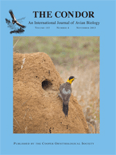
Ornithological Applications
Scope & Guideline
Fostering collaboration in the pursuit of ornithological excellence.
Introduction
Aims and Scopes
- Avian Ecology and Behavior:
Research exploring the ecological roles, behaviors, and life histories of birds, including their interactions with habitats and other species. - Conservation Strategies:
Studies that assess and propose management practices aimed at conserving bird populations and their habitats, particularly in the face of environmental change. - Impact of Climate Change:
Investigations on how climate change affects bird populations, migration patterns, and habitat availability, contributing to understanding the broader implications for biodiversity. - Citizen Science and Community Engagement:
Exploration of how citizen science initiatives enhance ornithological research and conservation efforts, fostering community involvement in bird monitoring and protection. - Technological Advancements in Avian Research:
Utilization of new technologies such as GPS tracking, acoustic monitoring, and data analysis software to improve the understanding of bird movement, behavior, and population dynamics. - Integrative Approaches to Research:
Encouraging interdisciplinary studies that combine ecological, genetic, and social science approaches to address complex issues in avian conservation.
Trending and Emerging
- Climate Resilience and Adaptation:
Research examining how bird species adapt to changing climates, including studies on phenological shifts and habitat use, is gaining traction as conservationists seek to enhance resilience. - Genetic Diversity and Conservation Genetics:
An increasing focus on the genetic aspects of bird populations, including genetic monitoring and implications for conservation strategies, highlights the importance of genetic health in species recovery. - Human-Wildlife Interactions:
Studies exploring the impacts of human activities on bird populations and how birds adapt to urban environments are becoming more prominent, emphasizing the need for coexistence strategies. - Innovative Conservation Methods:
The application of new technologies, such as drones and automated monitoring systems, is on the rise, providing more efficient ways to study and protect bird populations. - Cross-disciplinary Research:
Interdisciplinary approaches that integrate social sciences with ornithological research are emerging, focusing on how societal factors influence bird conservation efforts and public engagement. - Focus on Migratory Connectivity:
Research emphasizing the importance of migratory pathways and connectivity among populations is trending, as it is crucial for effective conservation planning across regions and countries.
Declining or Waning
- Traditional Habitat Studies:
Research focusing solely on habitat descriptions without integrating ecological dynamics or conservation implications is becoming less prevalent, as there is a push towards applied studies that address real-world issues. - Static Population Models:
The reliance on traditional population modeling approaches without considering environmental variability and dynamics is waning, as researchers seek more robust, adaptive modeling techniques. - Generalized Studies on Bird Migration:
Broad, non-specific studies on bird migration patterns are decreasing, with a growing emphasis on detailed, species-specific migration research that incorporates ecological and genetic factors. - Historical Data Analysis:
Research that merely focuses on historical bird population data without linking it to current conservation strategies or climate change impacts is becoming less common. - Focus on Non-threatened Species:
There is a noticeable decline in research dedicated to non-threatened species, as funding and interest shift towards endangered and vulnerable bird populations requiring urgent conservation actions.
Similar Journals
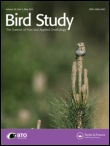
BIRD STUDY
Unveiling the secrets of avian evolution and behavior.BIRD STUDY, an esteemed journal published by Taylor & Francis Ltd, stands at the forefront of avian research, contributing significantly to the fields of ecology, evolution, behavior, and conservation. With its ISSN 0006-3657 and E-ISSN 1944-6705, this journal has been a cornerstone of ornithological studies since its inception in 1954 and continues to provide a critical platform for the dissemination of knowledge through 2024 and beyond. It holds a respectable Q3 quartile ranking in both Ecology, Evolution, Behavior and Systematics and Nature and Landscape Conservation, reflecting its pivotal role in the academic community. While the journal is not open access, it continues to attract submissions from a diverse array of researchers and professionals eager to share their findings on the intricate and dynamic interactions of birds within their ecosystems. As the global focus on biodiversity and conservation intensifies, BIRD STUDY remains dedicated to fostering knowledge and encouraging evidence-based practices that aim to protect avian species and their habitats.

MALIMBUS
Advancing avian science through rigorous research.MALIMBUS is a peer-reviewed journal published by the West African Ornithological Society, focusing on the study of avian biology and conservation. It aims to disseminate important research findings that contribute to the understanding of bird species, their habitats, and the challenges they face across West Africa and beyond. Although currently not available in an open-access format, the journal is an invaluable resource for ornithologists, ecologists, and industry professionals keen on advancing their understanding of avian science. Those engaged in research on bird migration, breeding behaviors, and conservation strategies will find MALIMBUS to be a vital platform for sharing innovative ideas and fostering collaborations. With its commitment to quality and rigorous review processes, MALIMBUS is an essential reference for anyone dedicated to studying and preserving avian diversity.
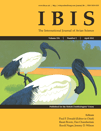
IBIS
Championing interdisciplinary approaches to animal science.IBIS, published by WILEY, stands as a prestigious journal in the field of animal science, zoology, and ecology since its inception in 1859. With a focus on innovative research that informs the scientific community on ecological dynamics, behavioral studies, and conservation strategies, IBIS fills a critical niche for researchers, professionals, and students alike. The journal is recognized for its robust impact factor and commands a Q1 ranking in three key categories as of 2023, demonstrating its influence and reach within the global academic landscape, particularly in Animal Science, Ecology, Evolution, Behavior and Systematics, and Nature and Landscape Conservation. Although not an open-access publication, its rigorous peer-review process ensures high-quality contributions that advance knowledge in these vital areas. Through interdisciplinary collaboration and comprehensive coverage of cutting-edge topics, IBIS remains an essential resource for those striving to understand and protect our natural world.

Ornithology Research
Advancing Knowledge in Ornithology and ConservationOrnithology Research is a leading academic journal published by SPRINGERNATURE, specializing in the field of avian studies and contributing to the broader category of Animal Science and Zoology. With a respectable Q2 ranking in its field as of 2023, this journal provides a dynamic platform for the dissemination of innovative research findings related to ornithology, ecology, and conservation. The journal, which transitioned to an Open Access model, ensures that its research is accessible to a global audience, fostering collaboration and knowledge sharing across disciplines. With an E-ISSN of 2662-673X, Ornithology Research serves the needs of researchers, professionals, and students dedicated to understanding the complexities of avian life. Its commitment to high-impact, peer-reviewed articles makes it an essential resource for anyone interested in advancing the science of ornithology.
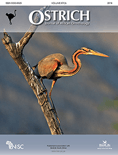
OSTRICH
Pioneering Research for Conservation and BiodiversityOSTRICH, a distinguished journal published by Taylor & Francis Ltd, serves as a pivotal platform for disseminating research in the fields of ecology, evolution, behavior, and systematics. With an ISSN of 0030-6525 and an E-ISSN of 1727-947X, this journal has been contributing vital insights to the scientific community since its inception in 1930. Maintained in the UK, OSTRICH holds a respectable Q3 category ranking in the 2023 Ecology, Evolution, Behavior, and Systematics quartiles and ranks 408th out of 721 within its scientific domain according to Scopus, showcasing a competitive position within the 43rd percentile. OSTRICH is committed to publishing high-quality research that informs conservation efforts and biodiversity studies, making it an essential resource for researchers, professionals, and students interested in avian biology and related ecological fields. While not currently an open-access journal, OSTRICH offers varied access options through institutions and libraries, further widening its reach and impact within the scientific community. We invite academics and practitioners to explore its valuable articles that drive forward innovations in avian research.
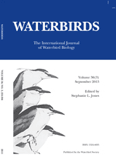
WATERBIRDS
Illuminating the World of Aquatic AvifaunaWATERBIRDS, published by the WATERBIRD SOC, serves as a vital scholarly resource in the field of Animal Science and Zoology. With its ISSN 1524-4695 and E-ISSN 1938-5390, this journal has established a significant presence since its inception in 1996, continuing to contribute valuable insights and research up to 2024. Recognized for its impact within the academic community, WATERBIRDS is currently positioned in the third quartile (Q3) for its category in 2023, ranking 335 out of 490 in Scopus's Agricultural and Biological Sciences sector, which underscores its role in promoting the study of avian species and their habitats. The journal is accessible to a wider audience, aligning with the growing demand for open access to scientific knowledge. By disseminating research that addresses both ecological and conservation issues pertinent to waterbirds, this publication serves as an essential platform for researchers, professionals, and students dedicated to advancing the understanding of avian biology and related fields.

JOURNAL OF AVIAN BIOLOGY
Exploring the intricacies of avian ecology and behavior.Journal of Avian Biology, published by Wiley, is a leading journal in the field of animal science and zoology, with an impressive impact factor highlighting its significance in advancing our understanding of avian ecology and behavior. Since its inception in 1994, this journal has provided a vital platform for researchers, professionals, and students to share innovative studies and findings related to avian biology, contributing to a broader understanding of ecological dynamics and conservation strategies. Recognized in the Q1 category for Animal Science and Zoology and Q2 for Ecology, Evolution, Behavior and Systematics, it ranks 112th out of 490 in its primary field, demonstrating a strong percentile performance. The journal invites submissions that explore diverse aspects of avian research, fostering interdisciplinary discussions that are crucial for ongoing scientific inquiries. With both print and electronic formats, it maintains an accessible repository of knowledge for the global conservation community. Engage with the latest in avian studies through the Journal of Avian Biology and contribute to the evolution of this critical field.
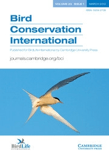
BIRD CONSERVATION INTERNATIONAL
Nurturing a global community dedicated to avian preservation.BIRD CONSERVATION INTERNATIONAL, published by Cambridge University Press, stands as a premier academic journal dedicated to the field of avian conservation and the vital ecological interactions that sustain bird populations worldwide. With an impressive impact factor reflected through its Q1 ranking in Animal Science and Zoology, alongside notable Q2 standings in Ecology and Nature and Landscape Conservation, this journal provides a crucial platform for researchers and practitioners committed to advancing the science and practice of bird conservation. Spanning articles from its inception in 1991 through to its future publications in 2024, BIRD CONSERVATION INTERNATIONAL not only fosters innovative research but also nurtures a global community dedicated to the preservation of avian species and their habitats. While currently not offering open access, it remains a cornerstone for scholarly communication in its field, making significant contributions to knowledge and policy shaping conservation efforts across the globe.

ORNIS FENNICA
Fostering a Deeper Understanding of Our Feathered FriendsORNIS FENNICA, published by BirdLife Finland, is a seminal journal dedicated to the field of ornithology and avian ecology. Established in Finland, this journal has been a vital resource for researchers, professionals, and students since its inception, evolving through converged publication periods from 1979 to 1985 and again from 1991 to the present. ORNIS FENNICA holds a Q2 category ranking in Animal Science and Zoology for 2023, indicating its significant influence and reputation within the academic community, as reflected in its Scopus ranking of 242 out of 490 in its field. The journal aims to promote the study of birds, encompassing aspects such as behavior, conservation, and biodiversity, thus serving as a crucial platform for disseminating innovative research findings. Although it is not open access, ORNIS FENNICA remains committed to advancing ornithological knowledge and supporting the scientific community's efforts to understand and protect avian species. For those invested in the nuances of bird research, this journal offers an invaluable repository of scholarly articles, reviews, and insights.

MARINE ORNITHOLOGY
Exploring the Depths of Marine Avian ScienceMarine Ornithology, published by the Pacific Seabird Group, is a vital resource in the field of animal science, zoology, and oceanography. With an ISSN of 1018-3337 and E-ISSN of 2074-1235, this journal has been a cornerstone for researchers and enthusiasts since its inception, actively contributing to the understanding of marine bird species and their ecosystems. Although it is currently not an open-access journal, it provides critical insights and findings that inform both academic research and practical conservation efforts. With its category quartiles positioned in Q3 for both Animal Science and Zoology, and Oceanography, Marine Ornithology occupies a significant, albeit competitive niche among scholarly publications. Researchers can benefit from its comprehensive coverage of marine avian studies, which is crucial for addressing the challenges these species face in changing oceanic environments. As the journal continues to evolve, with coverage from 1990 to 2024, it maintains an essential role in enriching our knowledge of marine biodiversity.